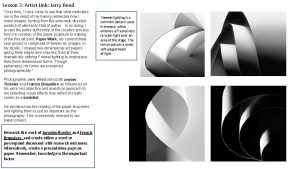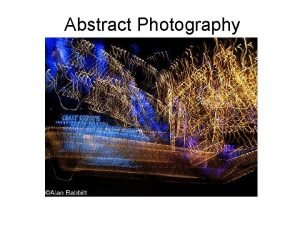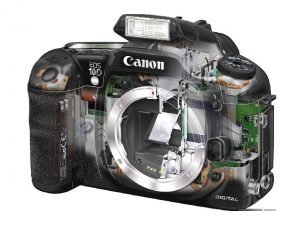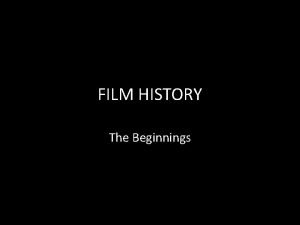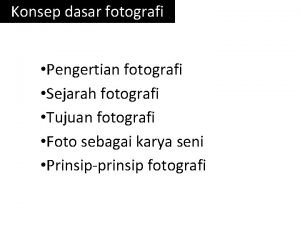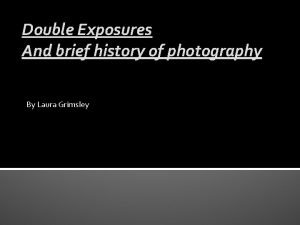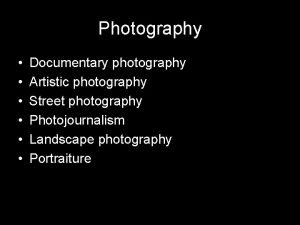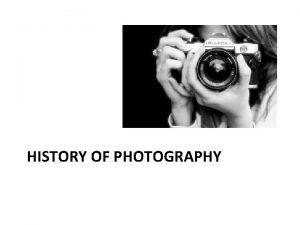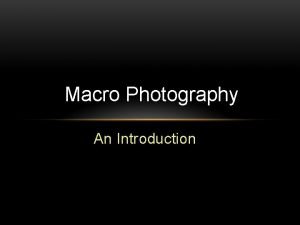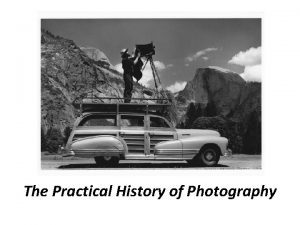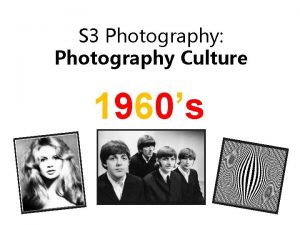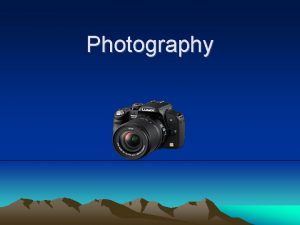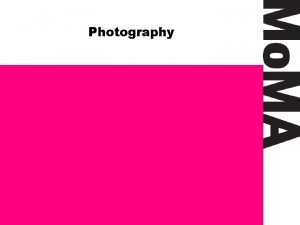History of Photography Jerry Qu Introduction Photography means














- Slides: 14

History of Photography ——Jerry Qu

Introduction � Photography means the art or practice of taking and processing photographs. � The history of photography has been around for nearly 200 years. � The working principle of modern cameras is share several similar components, a lens, a shutter, and recording surface, and they use these parts along with the physics of optics, to capture an image.

Early origin � The earliest principles of photography have been discovered by the ancients as early as 2, 000 years ago. � Nomads in the ancient Middle East are said to have noticed the phenomenon that they rest in tents during the day and occasionally see inverted images cast on tents, which come from the rear of the tent. � Aristotle mentioned the concept of “dark box” in his book “Problemata”. Ibn Al-Haytham uses pinhole device to observe the solar eclipse. These pinhole devices work exactly the same as the tools we now call pinhole cameras.

Early origin � It is worth mentioning that although the concept of "dark box" appeared as early as BC, it was not until 1604 that the word ", camera obscura" appeared. Mathematician Kepler was the first to use the word. � In the 15 th century, artists began to use dark boxes as auxiliary tools for painting. Brunelesky makes use of the principle of small hole imaging to copy and create perspective painting method. With the development of science and technology, in the 16 th century, people came up with convex lenses for the dark box to make the image clearer and brighter.

The birth of photography � The earliest surviving photographs were taken by the Frenchman Niepce in 1826. Niepce coated Jewish asphalt on a lead-tin alloy plate and captured the image for eight hours of exposure. He called the technique daylight etching, but he died before it was perfected. His partner, French painter Daguerre, continued his research and invented the Daguerre photography method, also known as the silver plate photography method (Daguerreotype), which was patented by the French government in 1839 and proclaimed the birth of photography on 19 August of the same year.

From scenery to portrait Early Daguerreotype, which took a long time to expose, took more than 10 minutes, making it difficult to photograph portraits and moving objects. At this stage, the most common subjects of photography are scenery and still life, while the most commercial potential is portraits. � In 1841, French photographer Claude used iodine chloride steam to process the metal photosensitive plate and successfully shortened the exposure time to seconds. Claude, who emigrated to the United Kingdom, bought a patent right in the United Kingdom for silver photography and opened of Film Building in London, UK. He was a very successful photographer and received many honors, but a fire turned his portrait into nothing. There is only a small amount left to pass on to the rest of the world. �

Wet plate processing � Fire-cotton rubber photography, also known as rubber-cotton printing process, can be divided down into wet plate and dry plate two kinds, firecotton glue photography is a kind of photography method appeared in 1850 s, its appearance almost replaced silver plate photography method. Firewood glue is a viscous liquid that can be glued to a smooth glass plate and used as a carrier of silver nitrate, so that this sensitive material is fixed on the glass plate and made into a photosensitive plate.

From the room to the outside � Outdoor photography requires collapsible cameras, retractable wooden tripods, portable tents and boxes to hold potions, bringing the entire darkroom out. Because of the use of Wet Plate Processing, the photosensitive plate should be prepared in advance and taken before the photosensitive plate is dry. Photosensitive version is not long-term storage, once dry can not take pictures. Even so, early photographers used this technique to take pictures outdoors.

Camera miniaturization � In 1914, German "Leitz" microscope factory designer Oscar Barnak tried to make double the size of the film (24 x 36 mm); 135) cameras (18 x 24 mm in film size), which began selling Leica cameras in 1924. 135 became the most popular film specification, greatly reducing the size of the camera and shifting the mainstream of photography to documentary photography. And quickly accepted by the public. � Digital camera technology was studied in the middle and late 20 th century and entered the civil market at the end of last century. In 1995 Kodak released the consumer digital camera DC 40, marking the beginning of the digital camera civilian market. With the development of digital technology and Internet application, digital products, such as mobile phones and so on, begin to be equipped with photography function. The pictures can be spread wirelessly by MMS, and photography begins to develop diversified.

The Time Line of Photography History Before 1984

Digital Camera A digital camera is a camera that converts an optical image into electronic data using an electronic sensor. It is different from a conventional camera which records images by chemical changes on a film caused by light. � In 1975, Stephen Sasson, an engineer at Eastman Kodak Company, developed first digital camera in the world, which uses tape as a storage medium and has 10, 000 pixels. It takes 23 seconds to record a black-and-white image. The appearance of this "hand-held electronic camera" upended the physical nature of photography. �

The Time. Line of Digital Cameras’ History

One of the Newest Digital Camera

Thank you!
 Jerry reed photographer
Jerry reed photographer Is abstract photography same as conceptual photography
Is abstract photography same as conceptual photography What is the meaning of the word photography
What is the meaning of the word photography It comes from greek photos
It comes from greek photos Photography came from the greek word photos which means
Photography came from the greek word photos which means History of digital photography
History of digital photography History of film photography
History of film photography Pengertian fotografi
Pengertian fotografi Famous abstract photographer
Famous abstract photographer Define commercial photography
Define commercial photography What did richard maddox invent
What did richard maddox invent Man ray double exposure
Man ray double exposure If poly means many, what is gon?
If poly means many, what is gon? Morphe means in metamorphism
Morphe means in metamorphism Meta means change and morph means heat
Meta means change and morph means heat
